
Salmonidae is a family of ray-finned fish that constitutes the only currently extant family in the order Salmoniformes, consisting of 11 extant genera and over 200 species collectively known as "salmonids" or "salmonoids". The family includes salmon, trout, char, graylings, freshwater whitefishes, taimens and lenoks, all coldwater mid-level predatory fish that inhabit the subarctic and cool temperate waters of the Northern Hemisphere. The Atlantic salmon, whose Latin name became that of its genus Salmo, is also the eponym of the family and order names.
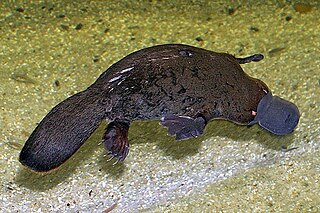
The Ornithorhynchidae are one of the two extant families in the order Monotremata, and contain the platypus and its extinct relatives. The other family is the Tachyglossidae, or echidnas.

Chelidae is one of three living families of the turtle suborder Pleurodira, and are commonly called Austro-South American side-neck turtles. The family is distributed in Australia, New Guinea, parts of Indonesia, and throughout most of South America. It is a large family of turtles with a significant fossil history dating back to the Cretaceous. The family is entirely Gondwanan in origin, with no members found outside Gondwana, either in the present day or as a fossil.

Gunnera is the sole genus of herbaceous flowering plants in the family Gunneraceae, which contains 63 species. Some species in this genus, namely those in the subgenus Panke, have extremely large leaves. Species in the genus are variously native to Latin America, Australia, New Zealand, Papuasia, Hawaii, insular Southeast Asia, Africa, and Madagascar. The stalks of some species are edible.

Osteoglossidae is a family of large freshwater fish, which includes the arowanas and arapaima. They are commonly known as bonytongues. The family contains two extant subfamilies Arapaiminae and Osteoglossinae, with a total of five living genera. The extinct Phareodontinae are known from the Late Cretaceous and Paleogene.
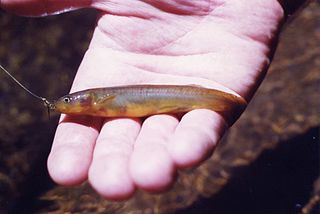
The Galaxiidae are a family of mostly small freshwater fish in the Southern Hemisphere. The majority live in Southern Australia or New Zealand, but some are found in South Africa, southern South America, Lord Howe Island, New Caledonia, and the Falkland Islands. One galaxiid species, the common galaxias, is probably the most widely naturally distributed freshwater fish in the Southern Hemisphere. They are coolwater species, found in temperate latitudes, with only one species known from subtropical habitats. Many specialise in living in cold, high-altitude upland rivers, streams, and lakes.
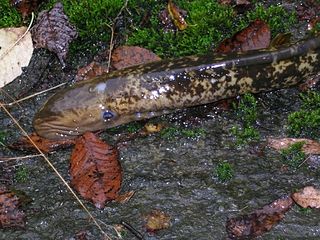
Cyclostomi, often referred to as Cyclostomata, is a group of vertebrates that comprises the living jawless fishes: the lampreys and hagfishes. Both groups have jawless mouths with horny epidermal structures that function as teeth called ceratodontes, and branchial arches that are internally positioned instead of external as in the related jawed fishes. The name Cyclostomi means "round mouths". It was named by Joan Crockford-Beattie.
Mordacia mordax, known as the short-headed lamprey, Australian lamprey or Murray lamprey, is a species of Mordacia that lives in south-eastern Australia and Tasmania. Mordaciidae is made up of three species: M. praedox, M. mordax, and M. lapicida. M. mordax is a relatively rare, parasitic vertebrate and, along with the hagfishes, is part of the only surviving group of jawless organisms throughout vertebrate evolution. It has a thin eel-like body up to 50 cm (20 in) long, with two low dorsal fins on the back half. The skin is blue-gray or brown. Its eyes are small, and located on the top of its head.

Mordacia praecox, the Australian brook lamprey or nonparasitic lamprey, is a freshwater species of southern topeyed lamprey that occurs in south-eastern Australia. It has a thin eel-like body around 12 to 15 cm long, with two low dorsal fins on the back half. The skin is dark blue above and grey below. Its eyes are small, and located on the top of its head. Unlike M. mordax, M. praecox has eyes that appear to have the potential for dichromatic vision despite being similarly adapted for low-light environments.

Geotria is the only genus in the lamprey family Geotriidae. It has 2 known species: Geotria australis and Geotria macrostoma. Both species were considered conspecific until G. macrostoma was revived in a 2020 study.

Lampetra is a genus of lampreys in the family Petromyzontidae.

Mordacia lapicida, also known as the Chilean lamprey, is a species of southern topeyed lamprey endemic to southern Chile, where it can be found in riverine and marine habitats. This species is anadromous. This parasitic lamprey can reach a length of 54 centimetres (21 in) SL. Ammocoetes and adults of this species are found in rivers, and occur in fine sand along river banks. The life cycle of a Mordacia lapicida is divided into three life stages: freshwater rearing, an ocean parasite and an adult spawning stage. Once in the adult stage, individuals migrate into marine waters where they attack and attach themselves to marine fishes.
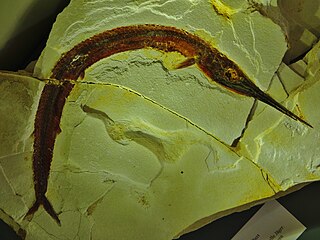
Aspidorhynchidae is an extinct family of ray-finned fish from the Mesozoic Era. It is the only member of the monotypic order Aspidorhynchiformes. Members of the group are noted for their elongated, conical rostrums, of varying length, formed from fused premaxillae. The range of the group extends from the Middle Jurassic to the end of the Maastrichtian, with a potential record from the Late Paleocene. The family and order were described by Pieter Bleeker in 1859.

Lampreys are a group of jawless fish comprising the order Petromyzontiformes. The adult lamprey is characterized by a toothed, funnel-like sucking mouth. The common name "lamprey" is probably derived from Latin lampetra, which may mean "stone licker", though the etymology is uncertain. Lamprey is sometimes seen for the plural form.
Caspiomyzon is a genus of lamprey in the family Petromyzontidae. They are native to Eastern Europe and parts of Western and Central Asia. Two of the three species in the genus are endemic to Greece.
Mioceratodus is an extinct genus of lungfish in the family Neoceratodontidae, which also contains the extant Queensland lungfish. It is known only from Oligocene and Miocene-aged sediments in Australia, although phylogenetic evidence supports it having first diverged from its closest relative, Neoceratodus, during the Late Jurassic or Early Cretaceous period.
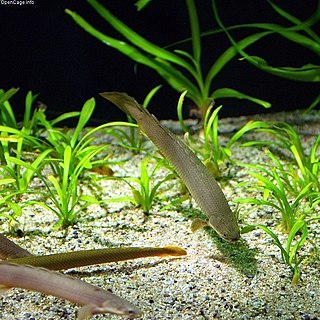
Cladistia is a clade of bony fishes whose only living members are the bichirs of tropical Africa. Their major synapomorphies are a heterocercal tail in which the dorsal fin has independent rays, and a posteriorly elongated parasphenoid.
Praecox is a Latin term meaning "very early". It is often used as a qualifying adjective in Latin binomials, and could mean "early flowering", "primitive", "premature" or "early onset".
Rubicundus is a genus of hagfishes, the only extant member of the subfamily Rubicundinae. All species in it were formerly classified in Eptatretus. R. eos, R. lakeside, and R. rubicundus are known from single specimens caught in the Tasman Sea, Galápagos, and Taiwan, respectively. They are named after the distinctive red coloration that all species share.

Arapaiminae is a subfamily of freshwater osteoglossiform (bony-tongued) fishes belonging to the family Osteoglossidae. It includes the South American arapaimas of the Amazon and Essequibo basins and the African arowana from the watersheds of the Sahelo-Sudanese region, Senegal, Gambia, and parts of Eastern Africa. This subfamily is sometimes raised to the rank of family, as Arapaimidae. A commonly used synonym is Heterotidinae, but according to the ICZN, Arapaiminae has priority.















